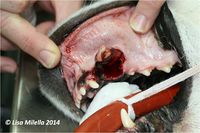Difference between revisions of "Luxated and Avulsed Teeth"
Jump to navigation
Jump to search
m (Text replace - "[[Category:Waltham reviewing" to "[[Category:Waltham reviewed") |
|||
| Line 16: | Line 16: | ||
[[Category:Traumatic Dental Conditions]] | [[Category:Traumatic Dental Conditions]] | ||
[[Category:LisaM reviewed]] | [[Category:LisaM reviewed]] | ||
| − | [[Category:Waltham | + | [[Category:Waltham reviewed]] |
Revision as of 15:37, 30 September 2014
Introduction
Occasionally, veterinarians are presented with luxated or avulsed teeth.
Luxated = partly dislocated from the socket. The most common luxation is a lateral luxation together with fracture of the alveolar bone plate.
Avulsed = completely removed/pulled out of the socket
In these cases of trauma, the blood supply to the tooth is affected, resulting in pulp necrosis.
Injured teeth will require treatment - either extraction or replacement and stabilization, and once the tooth has re-attached, endodontic treatment will be required.
